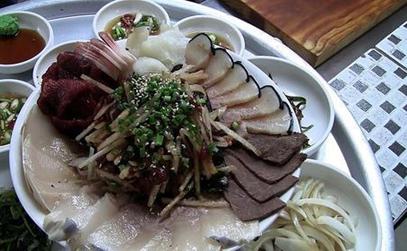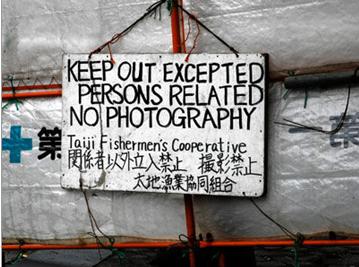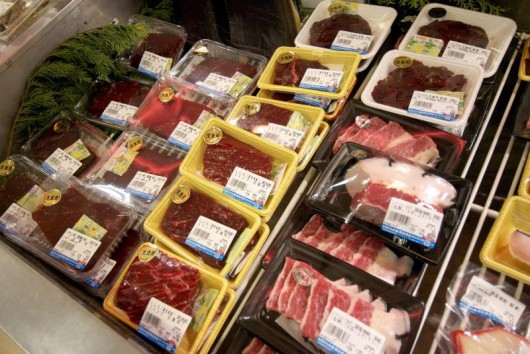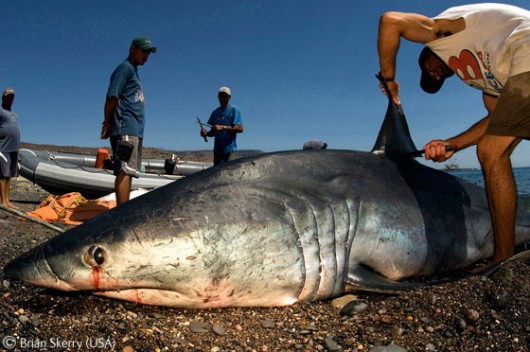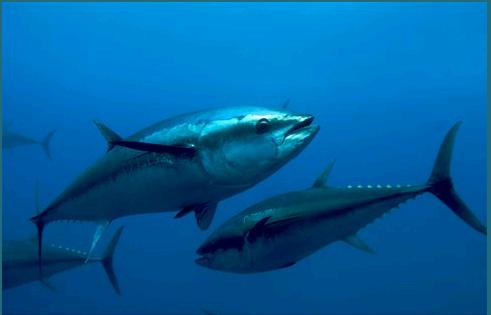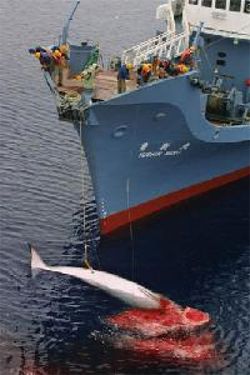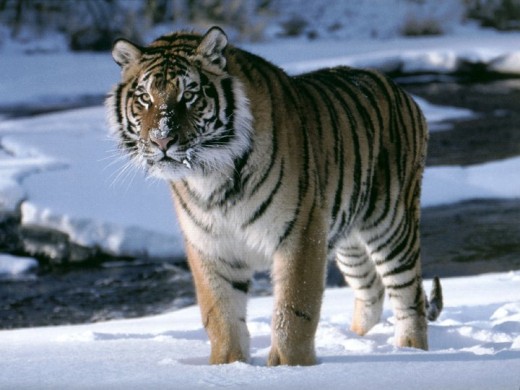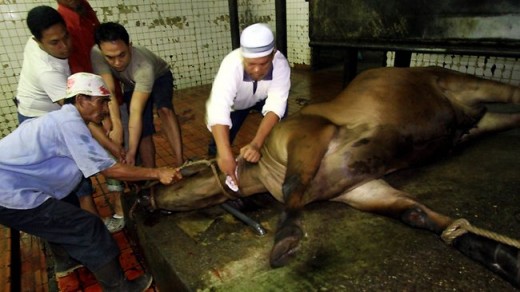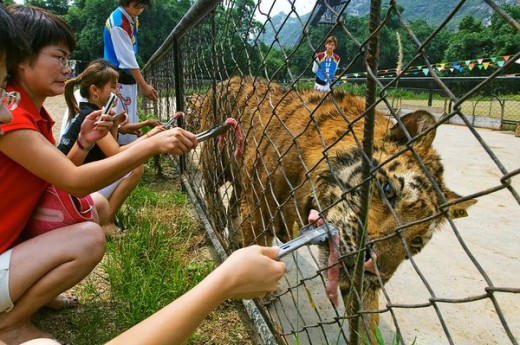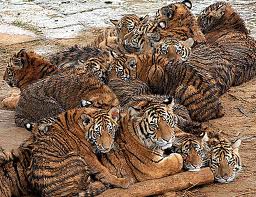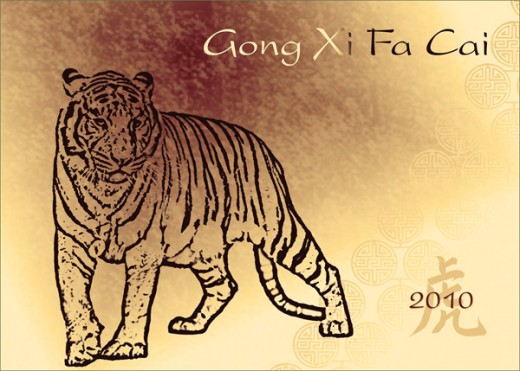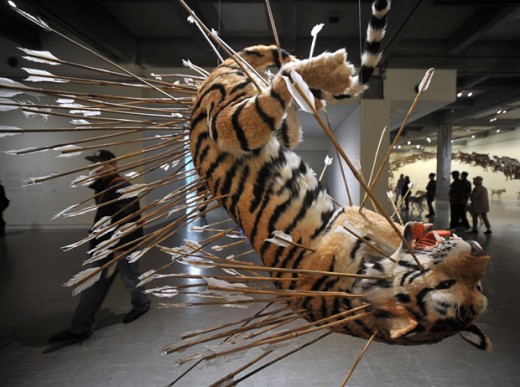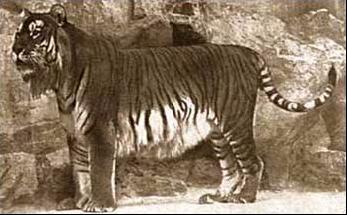Lies, Damn Lies and ‘Scientific Whaling’
Tuesday, January 10th, 2012Japanese contempt for whales, dolphins and sharks has highlihghted to the world the backward culture of this part of traditional Japanese society. Japanese whalers and fishing corporations have made Japan the pariah of the world’s oceans.
The Japanese lie of scientific whaling has become a cliched euphemism. Now the science has been officially confirmed as a fraud, as if we didn’t already know.
.
The following article has just been published in the online Science Daily:
.
‘DNA analysis suggests whale meat from sushi restaurants in L.A. and Seoul originated from Japan’
[Source: ScienceDaily (Apr. 14, 2010]
.
“An international team of Oregon State University scientists, documentary filmmakers and environmental advocates has uncovered an apparent illegal trade in whalemeat, linking whales killed in Japan’s controversial scientific whaling program to sushi restaurants in Seoul, South Korea, and Los Angeles, Calif.
Genetic analysis of sashimi served at a prominent Los Angeles sushi restaurant in October of 2009 has confirmed that the strips of raw meat purchased by filmmakers of the Oscar-winning documentary, “The Cove,” came from a sei whale — most likely from Japanese “scientific whaling.”
Do you want dolphin with that? ‘Scientists have identified four species of whales and one species of dolphin from a plate of sashimi, like this one sold in a restaurant in Seoul. (Credit: Photo courtesy of Louie Psihoyos, Oceanic Preservation Society)’
“The sequences were identical to sei whale products that had previously been purchased in Japan in 2007 and 2008, which means they not only came from the same area of the ocean — but possibly from the same distinct population,” said Scott Baker, associate director of the Marine Mammal Institute at Oregon State University, who conducted the analysis.
“And since the international moratorium on commercial hunting (1986), there has been no other known source of sei whales available commercially other than in Japan,” Baker added. “This underscores the very real problem of the illegal international trade of whalemeat products.”
Results of the study were published in the Royal Society journal Biology Letters. “The Cove” director Louie Psihoyos and assistant director Charles Hambleton gained the attention of international news media recently by covertly filming the serving of whale products at The Hump restaurant.
Following initial identification of the samples taken from the restaurant, the products were turned over to the National Oceanic and Atmospheric Administration’s law enforcement division and in March, federal prosecutors filed a criminal complaint against the restaurant, which since has closed. Baker said the samples taken from The Hump cannot conclusively be linked to an individual whale because genetic identity records of animals killed through Japan’s scientific whaling are not released by the Japanese government. In their paper in Biology Letters, Baker and 10 co-authors — including “The Cove” filmmakers — call for Japan to share its DNA register of whales taken from that country’s scientific whaling program and “bycatch” whaling.
“Our ability to use genetics as a tool to monitor whale populations around the world has advanced significantly over the past few years,” Baker said, “but unless we have access to all of the data — including those whales killed under Japan’s scientific whaling — we cannot provide resource managers with the best possible science.
“This is not just about better control of whaling itself,” Baker added, “but getting a better handle on the international trade of whale products.”
In their paper published in Biology Letters, lead author Baker and colleagues from the Korean Federation of Environmental Movements also report on 13 whale products purchased at a sushi restaurant in Seoul, South Korea, during two 2009 visits. The sushi was part of a mixed plate of “whale sashimi,” and genetic testing by Baker and OSU’s Debbie Steel determined that four of the products were from an Antarctic minke whale, four were from a sei whale, three were from a North Pacific minke whale, one was from a fin whale, and one was from a Risso’s dolphin.
Further testing by collaborators from Seoul National University confirmed the individual identity of the whale products by DNA “profiling.” The DNA profile of the fin whale meat from the Seoul restaurant genetically matched products purchased by Baker’s colleague, Naoko Funahashi, in Japanese markets in 2007 — strongly suggesting it came from the same whale.
“Since the international moratorium, it has been assumed that there is no international trade in whale products,” Baker said. “But when products from the same whale are sold in Japan in 2007 and in Korea in 2009, it suggests that international trade, though illegal, is still an issue. Likewise, the Antarctic minke whale is not found in Korean waters, but it is hunted by Japan’s controversial scientific whaling program in the Antarctic.
“How did it show up in a restaurant in Seoul?”
Baker has developed an international reputation for his research in determining the origin of whalemeat products sold in markets around the world. His research on identification of dolphin meat contaminated with high levels of mercury was featured in “The Cove,” where he worked with Psihoyos and Hambleton. In their paper, the authors describe the long legacy of falsifying whale catch records, beginning with the Soviet Union, which failed to account for more than 100,000 whales it killed in the 20th century. This illegal, unreported or unregulated whaling “continues today under the cover of incidental fisheries bycatch and scientific whaling.”
.
Japanese love slaughtering dolphins too!
.
Each year at a cove near Taiji on the south east cost of central Japan, thousands of bottlenose dolphins and pilot whales are slaughtered by the Japanese. The cull is endorsed by the Japanese goivernment to commence on 1st September every year.
Bottlenose Dolphin, confimed as one of the most intelligent animals on the planet Typically, over six months the town’s fishermen will catch over 2,000 of Japan’s annual quota of 20,000
dolphins. Dolphin slaughter turns sea red as Japan hunting season returns “In a typical hunt the fishermen pursue pods of dolphins across open seas, banging metal poles together beneath the water to confuse their hypersensitive sonar. The exhausted animals are driven into a large cove sealed off by nets to stop them escaping and dragged backwards into secluded inlets the following morning to be butchered with knives and spears. They are then loaded on to boats and taken to the quayside to be cut up in a warehouse, the fishermen’s work hidden from the outside by heavy shutters.
‘Tensions have been rising and the culls conducted in near-secrecy since 2003, when two members of the marine conservation group Sea Shepherd released several dolphins that were being kept in an enclosure ready to be slaughtered.
During our visit we were followed at almost every turn, ordered not to take photographs and questioned by the police, who seem to view every foreign visitor as a potential hunt saboteur. None of the residents who agreed to talk would reveal their names, and requests for comments from the town office were ignored. Criticism of the dolphin hunts intensified this summer with the release of the award-winning US documentary The Cove, whose makers used remote-controlled helicopters and hidden underwater cameras to record the hunters at work. The film was released in the UK last October.
The film, with its graphic footage of the dolphin slaughter, sparked outrage after its release in the US and Australia. Last month councillors in the Australian coastal town of Broome suspended its 28-year sister-city relationship with Taiji after receiving thousands of emails protesting at the culls.
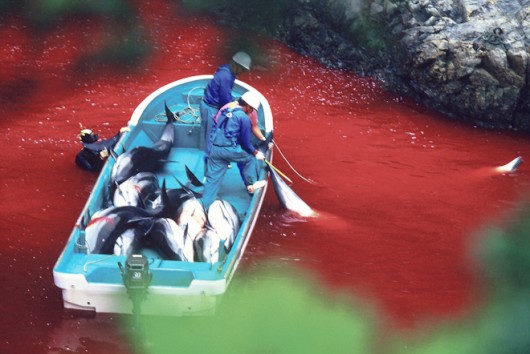 Japanese annual dolphin slaughter at The Cove, Taiji, Japan
Japanese annual dolphin slaughter at The Cove, Taiji, Japan
.
Taiji is regarded as the spiritual home of Japan’s whaling industry. The first hunts took place in the early 1600s, according to the town’s whaling museum, but the industry went into decline after the introduction of a global ban on commercial whaling in 1986. The town, a six-hour train ride from Tokyo, is dotted with restaurants serving whale and dolphin sashimi and cetacean iconography appears on everything from the pavements and bridge balustrades to road tunnels and a wind turbine.”
[Source: ‘Dolphin slaughter turns sea red as Japan hunting season returns’, by Justin McCurry, The Guardian, 14-Sep-09, ^http://www.guardian.co.uk/world/2009/sep/14/dolphin-slaughter-hunting-japan-taiji]...
Call to boycott Japanese restaurants
.
This slaughter of whales, dolphins and endangered fish such as Bluefin and sharks confirms the barbaric backwardness of traditional cultures in east Asia. Japan clearly is making a point to highlight its backwardness.
Around the world, including in Australia, Japanese restaurants continue to serve up Bluefin Tuna and Shark Fin soup and probably ‘scientific’ whale meat and dolphin. It is a disgrace!
Bluefin is critically endangered and both the scalloped hammerhead shark and whitetip shark “have seen their numbers drop dramatically since the 1980s, due to rising demand for shark fin soup especially among China’s nouveau rich and for fish and chips in Europe. Surging demand for shark fin soup among Asia’s booming middle classes is driving many species of these big fish to the brink of extinction.”
.
In this March 8, 2010 photo, a woman walks past shark fins displayed in a glass case at a dried seafood shop in Hong Kong.
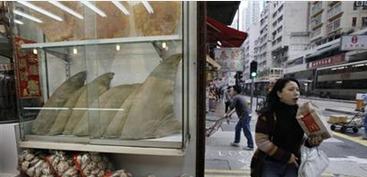 Shark Fins for sale in Hoing Kong
^http://www.physorg.com/news187936927.html
Shark Fins for sale in Hoing Kong
^http://www.physorg.com/news187936927.html
.
The following example Japanese restaurants in Australia sell Bluefin and shark fin. It is time Australians boycotted such trades perpetuating wildlife extinctions.
* SYDNEY: Blue Fin Seafood Restaurant, Brighton-Le-Sands Amateur Fishermans Club, Bestic St, Brighton-Le-Sands NSW 2216
* MELBOURNE: Blue Fin, 342 Brunswick St, Fitzroy VIC 3065
* BRISBANE: Oishii Sushi Bar Shop2/70 Pinelands Rd Sunnybank Hills, Brisbane
Don’t buy Japanese – it only perpetuate’s Japan’s arrogance
.
Back in 2000, Australia and New Zealand sought an international ruling at the International Court of Justice under United Nations Convention on the Law of the Sea (UNCLOS) against Japan’s fishing of Southern Bluefin Tuna in the Southern Ocean.
Ridiculously, the court found that it had no jurisdiction to make binding rulings on Japan’s access to high seas fisheries, and that Japan can make “its own unilateral decisions as to what to fish, and where.”
So Japan continued to unilaterally embarke on a three year “Experimental Fishing Program” (EFP), that…is we want the tuna and no-one is getting in our way!
Last month at CITES COP15 meeting, Monaco had called for a global ban on bluefin tuna fishing by CITES, arguing despite stocks having fallen by about 85%, the organisation responsible for managing the bluefin fishery – the International Commission for the Conservation of Atlantic Tunas (ICCAT) – had not implemented measures strict enough to ensure the species’ survival. Australia voted against the ban, supporting Japan. ICCAT is due to meet on the bluefin issue on 14 June 2010 in Madrid Spain.
Meanwhile, in the Southern Ocean, the Commission for the Conservation of Southern Bluefin Tuna is a voluntary fishery management group comprised of Australia, Japan, New Zealand, South Korea and the Philippines as a formal cooperating non-member. Much of the Southern Bluefin Tuna catch ends up in Japan where it is prized as sushi and sushimi.
Australia’s tuna fishing industry is based in Port Lincoln in South Australia. Japanese, Korean, Indonesian and Taiwanese Bluefin tuna fleets use long line fishing which results in the incidental deaths of thousands of seabirds, particularly petrels and albatross.
For over 20 years Japan has plundered the Southern Bluefin Tuna Fishery under its unilaterally imposed ‘Experimental Fishing Program (EFP)’, similar in deception as ‘Japanese scientific whaling’. According to Humane Society International, the Scientific Committee to the Commission has estimated the SBT population is at a mere 3-8% of its pre-exploitation biomass.
.
It is time to boycott Japanese sushi, sushimi, seafood restaurants and indeed all Japanese products, until Japan’s arrogant poaching of protected and endangered marine life is stopped!
.
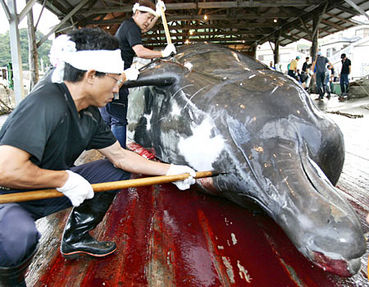 Japanese carving up Minke Whale
Japanese carving up Minke Whale
